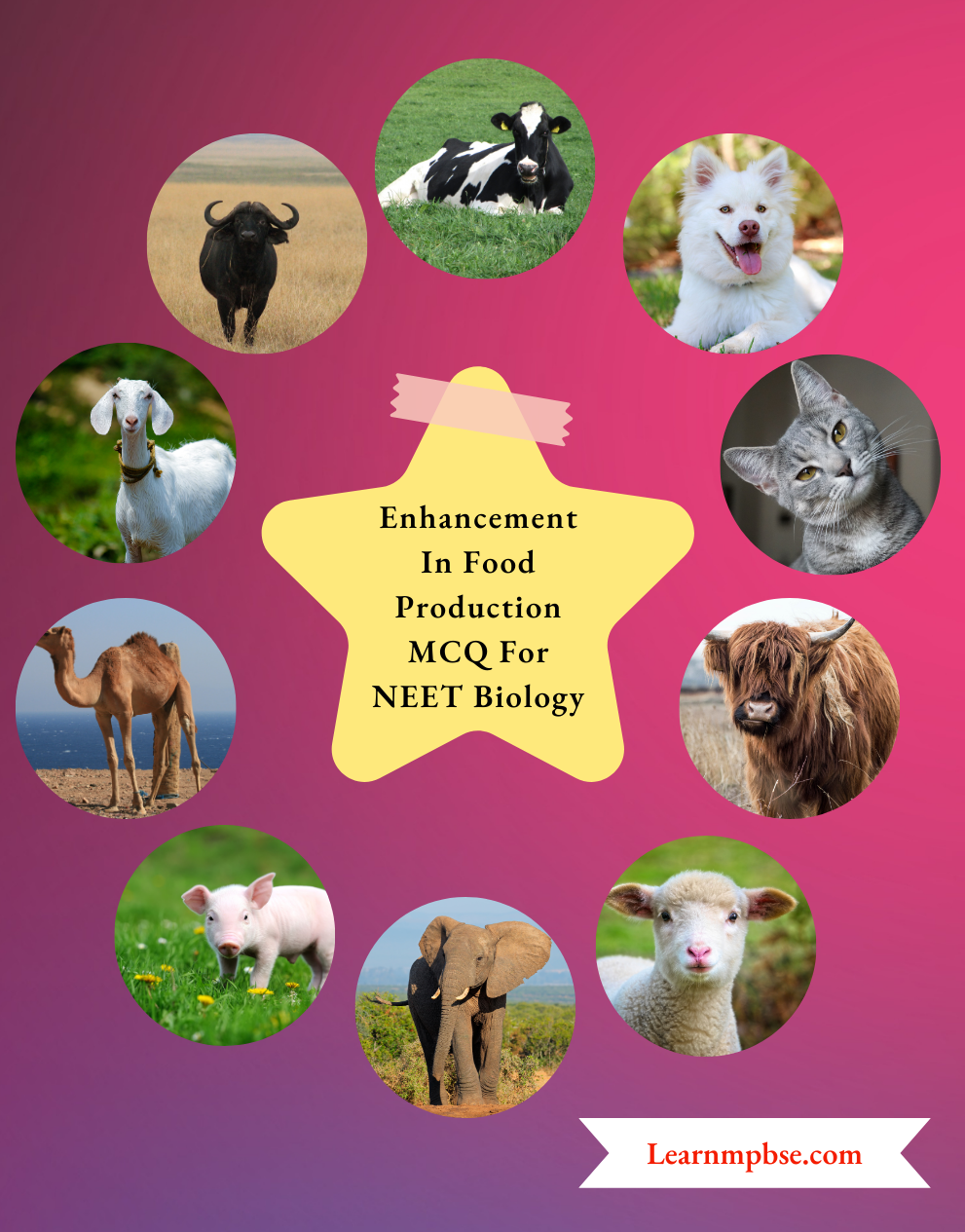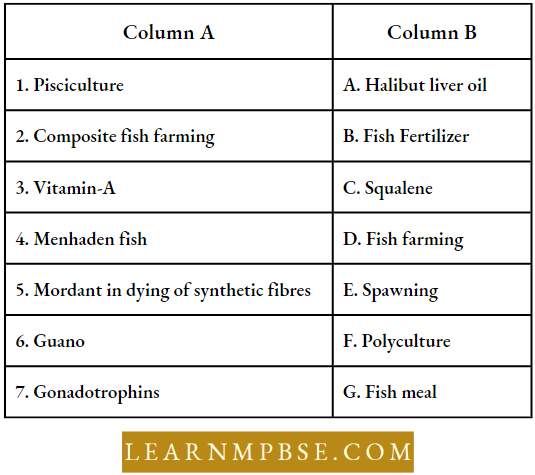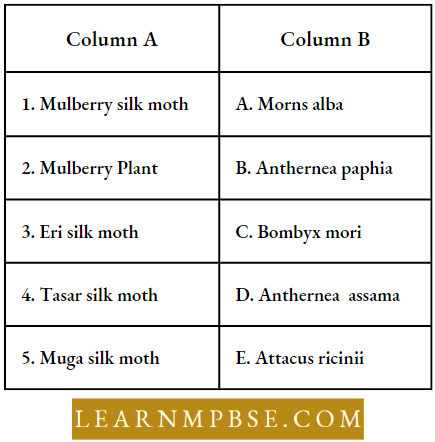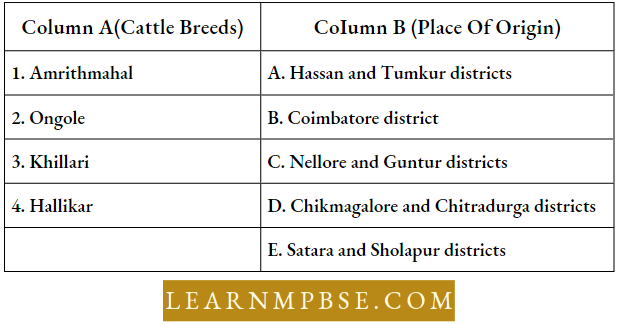Enhancement In Food Production MCQ For NEET Biology
Question 1. Maximum contrilnilion to the total milk production of our country comics from:
- Cows
- Buffaloes
- Camels
- Goat.
Answer: 2. Buffaloes
Question 2. Murrah is a breed of:
- Cow
- Sheep
- Buffaloes
- Goat
Answer: 3. Buffaloes
Question 3. Lac is a:
- Plant product
- Mineral product
- Synthetic product
- Animal product.
Answer: 4. Animal product.
Question 4. Aquaculture includes:
- Freshwater fishing
- Brackish water fishes
- Marine fishery
- All of the above.
Answer: 4. All of the above.
Read and Learn More NEET Biology Multiple Choice Question and Answers
Question 5. Which of the following species is specially domesticated and reared for high economic importance?
- Apis indica
- Apis mellifera
- Apis dorsata
- Apis florea.
Answer: 1. Apis Indica

Question 6. Cryopreservation is:
- Preservation of living beings in chemicals
- Preservation at very low temperature
- Preservation through exposure to irradiation
- Preservation at high temperature.
Answer: 2. Preservation at very low temperature
Enhancement In Food Production Mcq For Neet
Question 7. Cryopreservation is useful for:
- Preservation of semen
- Very young fetuses
- Living cells and body parts
- All the above.
Answer: 4. All the above.
Question 8. Exotic breeds:
- Require specific environment
- Hardy and high-yielding
- Are sturdy
- Take less food.
Answer: 1. Require specific environment
Question 9. Exotic breeds are:
- Used for cross-breeding
- Allowed to multiply and replace local breeds
- Easy to manage
- Resistant to local pests and pathogens.
Answer: 1. Used for cross-breeding
Question 10. Infertility of local breeds of cattle can be overcome by the use of:
- Cross-breeding with exotic breeds
- Good nourishment
- Stilbesterol
- Gonadotropin.
Answer: 4. Gonadotropin.
Question 11. Stilbesterol is used for:
- Induction of lactation
- Artificial insemination
- Super-ovulation
- Cryopreservation.
Answer: 1. Induction of lactation
Question 12. A surrogate mother is:
- Mother without lactation
- Future mother with embryo implanted from another
- Carrying several embryos at one time
- Artificially inseminated female
Answer: 2. Future mother with embryo implanted from another
Enhancement In Food Production Mcq For Neet
Question 13. Artificial insemination is better than natural insemination in cattle because
- Semen of good bulls can be provided everywhere
- There is no likelihood of contagious diseases
- It is economical
- All the above.
Answer: 4. It is economical
Enhancement of Food Production MCQs Question 14. A milch breed of cow is:
- Haryana
- Malvi
- Kankrcj
- Hallikcr.
Answer: 1. Haryana
Question 15. A draught breed of cattle is:
- Red Sindhi
- Gir
- Malvi
- Haryana.
Answer: 3. Malvi
Question 16. An exotic breed of cow is:
- Ongolc
- Friesian
- Hallikcr
- Deoni.
Answer: 2. Friesian
Question 17. Hybrid breed of cattle is:
- Sunandini
- Holstein
- Brown Swiss
- Kankrcj.
Answer: 1. Sunandini
Neet Biology Food Production Mcqs
Question 18. The gestation period for buffalo is:
- 9 months
- 14 months
- 10 months
- 21-22 months.
Answer: 3. 10 months
Question 19. Cows and buffaloes remain in heat for:
- 24-36 hours
- 36-48 days
- 7-10 days
- 15-20 days.
Answer: 1. 24-36 hours
Enhancement of Food Production MCQs Question 20. Bhutia is a breed of:
- Chicken
- Goat
- Sheep
- Horse.
Answer: 4. Horse
Question 21. Ship of the desert is:
- Elephant
- Camel
- Sheep
- Goat.
Answer: 2. Camel
Question 22. The animal most useful on difficult terrain
- Mule
- Yak
- Camel
- Elephant.
Answer: 1. Mule
Question 23. Bactrian camel is characterized by:
- Two humps and a long neck
- Two humps and long limbs
- Two humps and a thick coat
- Single hump and thick coat.
Answer: 3. Two humps and a thick coat
Question 24. A beast of burden that needs little care is:
- Pig
- Donkey
- Mule
- Yak.
Answer: 2. Donkey
Question 25. The largest land animal is:
- Camel
- Elephant
- Rhino
- Python.
Answer: 2. Elephant
Question 26. Elephants are sought after for:
- Skin
- Hair
- Meat
- Ivory.
Answer: 4. Ivory.
Food Production And Management Mcq Neet
Question 27. The earliest animal to be domesticated was:
- Goat
- Dog
- Horse
- Cat.
Answer: 2. Dog
Question 28. The most used domesticated animal by Eskimos is:
- Cow
- Sheep
- Goat
- Husky.
Answer: 4. Husky.
Question 29. Huskies are:
- Yaks
- Donkeys
- Thick coated dogs
- Water buffaloes.
Answer: 3. Thick coated dogs
Question 30. The best source for dietary protein for a vegetarian is:
- Soya Bean
- Gram
- Groundnut
- Milk.
Answer: 4. Milk.
Food Production And Management Mcq Neet
Question 31. Zebu cattle are:
- Water Buffalo
- Indian Buffalo
- Cow
- Sheep
Answer: 3. Cow
Question 32. Cow Water Buffalo is
- European breed of buffalo that prefers living in water for most of the day
- Buffalo-like animals living in rivers
- Llama
- Buffalo.
Answer: 4. Buffalo.
Question 33. Which is the real product of Honey bee:
- Honey
- Pollen
- Beeswax
- Propolis.
Answer: 3. Beewax
Question 34. The hatching net is called:
- Nursery kind
- Production pond
- Stocking pond
- Hapa.
Answer: 4. Hapa.
Question 35. Spawning in fishes can be induced by:
- TSH
- Thyroxine
- FSH and LH
- STH.
Answer: 3. FSH and LH
Food Production And Management Mcq Neet
Question 36. The percentage of proteins in the fish meal is:
- 15-20%
- 25-50%
- 40-50%
- 55-70%.
Answer: 4. 55-70%.
Question 37. The rearing and breeding of fish in ponds, tanks, and artificial reservoirs are called
- Aquaculture
- Fishing
- Pisciculture
- Apiculture.
Answer: 3. Pisciculture
Question 38. Composite fish farming is called
- Polyculture
- Pisciculture
- Monoculture
- None of these.
Answer: 1. Polyculture
Question 39. Pisciculture has a bright future in India due to:
- Considerable demand
- Good response of native fishes to culture
- Abundance of cultivable waters
- All of these.
Answer: 4. All of these.
Question 40. Silk, honey, and lac are:
- Secretory substances of insects
- Secretory substances of plants
- Artificial chemicals
- All of the above.
Answer: 3. Artificial chemicals
Question 41. Match the terms in Column A with suitable terms in Column B.

- (1—D) (2—F), (3—G), (4—C), (5—A), (6—B), (7—E)
- (1—D). (2—F), (3—A), (4—C), (5—B), (6—E), (7—C)
- (1—D), (2-F), (3—A), (4—G), (5—C), (6—B), (7—E)
- (1—D), (2—F), (3—G), (4—C), (5—B), (6—A), (7—E)
Answer: 3. (1—D), (2-F), (3—A), (4—G), (5—C), (6—B), (7—E)
Question 42. The draught breeds of cattle include:
- Malvi, Nageri and Hallikar
- Malvi, Nageri and Ongole
- Nageri, Ongole and Haryana
- All the above.
Answer: 1. Malvi, Nageri and Hallikar
Food Production And Management Mcq Neet
Question 43. The method maximum used in cattle breeding is:
- Random breeding
- Artificial insemination
- Controlled breeding
- Superovulation and embryo transplant.
Answer: 2. Artificial insemination
Question 44. Rinderpest is the disease of:
- Cattle
- Poultry
- Fish
- Camel.
Answer: 1. Cattle
Question 45. Which of the following countries has the maximum average annual milk yield per cow?
- United Kingdom
- U.S.A.
- Denmark
- India.
Answer: 2. U.S.A.
Question 46. Which of the following countries has a minimum average annual milk yield per cow?
- India
- Pakistan
- Netherlands
- England.
Answer: 1. India
Question 47. Which of the following diseases in poultry is caused by nutritional deficiency?
- Perosis
- Fowl pox
- Coryza
- Aspergillosus.
Answer: 1. Perosis
Question 48. Ranikhet or New Castle Disease ‘of poultry is caused by:
- Bacteria
- Virus
- Fungus
- None of these.
Answer: 2. Virus
Biotechnology In Food Production Mcq
Question 49. The animal close to human beings which is cloned by an American scientist Dr. Don Wolf 1996 is:
- Gorilla
- Chimpanzee
- Gibbon
- Monkey.
Answer: 4. Monkey.
Question 50. Ambergris is the secretion from the intestine used in the manufacture of perfumes and other cosmetics:
- Tachyglossus- Echidna
- Physeter-Sperm whale
- Musk-Deer
- Kangaroo-Macropus.
Answer: 2. Physeter-Sperm whale
Question 51. Parthenogenesis is commonly round in:
- Ants, boos, and wasps
- Ascaris, oarlliwonn, and liver fluke
- Frogs, fishes, and foxes
- Starfish, Jellyfish, and cuttlefish.
Answer: 1. Ascaris, oarlliwonn, and liver fluke
Question 52. The length of silk fiber which surrounds a cocoon is about:
- 800 to 1200 yards
- 8000 to 12000 yards
- 800 to 1200 feet
- 8000 to 12000 meters.
Answer: 1. 800 to 1200 yards
MCQs on Enhancement of Food Production Question 53. The technique of silk production from the cocoons of silkworms was first known to:
- India
- China
- United Kingdom
- U.S.A.
Answer: 2. China
Question 54. Maximum cocoon and raw silk production is in:
- China
- Japan
- U.S.S.R.
- Brazil.
Answer: 1. China
Question 55. Central Silk Research and Training Institute (CSRTI) is located at:
- Assam
- Bahrampur
- Tarai region
- Shanthivials (Mysore).
Answer: 4. Shanthivials (Mysore).
Biotechnology In Food Production Mcq
Question 56. Most commercial silkworm strains are:
- Uni-voltine
- Vi-colline
- Multi-volcanic
- All of these.
Answer: 2. Vi-colline
MCQs on Enhancement of Food Production Question 57. The larval form of the silk moth is called:
- Naiad
- Maggot
- Caterpillar
- Wriggler.
Answer: 3. Caterpillar
Question 58. Eri silk is produced by:
- Bombyx mori
- Atticus ricin
- Anthenea roylre
- Anthenea paphia.
Answer: 2. Attcicus ricin
Question 59. Passive, non-locomotory, and non-feeding stages in the life history of the Silk moth are:
- Caterpillar
- Imago
- Nymph
- Pupa.
Answer: 4. Pupa.
Question 60. Nosemia sp. a protozoan produces diseases in:
- Silk moth
- Honey bee
- Both silk moth and honey bee
- Lac insect.
Answer: 3. Both silk moth and honey bee
Question 61. Which type of silk is obtained from Bombyx mori?
- Reeled silk
- Muga silk
- Arandi silk
- Tasar silk.
Answer: 1. Reeled silk
Biotechnology In Food Production Mcq
Question 62. Silk glands of silkworms are modified:
- Crop glands
- Salivary glands
- Gastric glands
- Intestinal glands
Answer: 2. Salivary glands
Question 63. Hinny Finny is a crossbreed between
- Male donkey and female horse
- Female donkey and male horse
- Male mule and female horse
- None of these.
Answer: 2. Male mule and female horse
Question 64. Match the terms of Column A with suitable terms in column B.

- (1-C), (2-B), (3-E), (4-D), (5-A)
- (1—C), (2—A), (3—E), (4—D), (5-B)
- (1—C), (2—A), (3—E), (4—B), (5—D)
- (1—E), (2—E), (3—B), (4—A), (5—D).
Answer: 3. (1—C), (2—A), (3—E), (4—B), (5—D)
Question 65. Poultry includes:
- Fowl, duck, tortoise, and turkey
- Fowl, duck, pigeon, and tortoise
- Duck, fowl, tortoise and turtle
- Fowl, duck, turkey, and pigeon.
Answer: 4. Fowl, duck, turkey, and pigeon.
Question 66. The percentage of proteins in the egg white is:
- 12%
- 35%
- 64%
- 70%.
Answer: 3. 64%
Question 67. The main protein type found in egg white is:
- Ovalbumin
- Canalbumin
- Phosvitin
- Lipovitellin.
Answer: 1. Ovalbumin
Food Security And Gm Crops Mcq Neet
Question 68. Central Food Technological Research Institute is located at:
- Izatnagar
- Lucknow.
- Dehradun
- Mysore.
Answer: 4. Mysore
Question 69. Which one of the following is our indigenous breed of chicken?
- Plymouth Rock
- White Leghorn
- Aseel
- Rhode Island Red.
Answer: 3. Aseel
NEET Biology Strategies for Enhancement in Food Question 70. A hybrid variety produced, having more meat-producing capacity, in chickens is:
- Broilers
- Plymouth rock
- White Romish
- New Hemisphere.
Answer: 1. Broilers
Strategies For Enhancement In Food Production Animal Sources Questions From Competitive Examinations
Question 1. Which of the following lias have been recently used for increasing the productivity of super milk cows:
- Artificial insemination by a pedigree bull only
- Superovulation of a high-production cow only
- Embryo transplantation only
- A combination of superovulation, artificial insemination, and embryo transplantation into a carrier cow (surrogate mother).
Answer: 4. A combination of superovulation, artificial insemination, and embryo transplantation into a carrier cow (surrogate mother).
Question 2. The name of the sheep that was cloned for the first time is:
- Dolly
- Polly
- Molly
- Holly.
Answer: 3. Molly
Question 3. Inland fisheries is referred to as:
- Culturing fish in freshwater
- Trapping and capturing fish from seacoast
- Deep sea fishing
- Extraction of oil from fish.
Answer: 1. Culturing fish in freshwater
Question 4. On the basis of utility. Nagapuri buffaloes are categorized as:
- Grazers
- Dual purpose
- Draught cattle
- Milkers.
Answer: 4. Milkers.
Question 5. Natural silk contains:
- Potassium
- Phosphorus
- Nitrogen
- Magnesium.
Answer: 3. Nitrogen
Food Security And Gm Crops Mcq Neet
Question 6. In India the best aquarium is located at:
- Z.S.I. Kolkata
- Tarapur, Mumbai
- Chennai
- Vishakhapatnam.
Answer: 2. Chennai
Question 7. Pearl oyster belongs to class:
- Gastropoda
- Pelecypoda
- Scaphopoda
- Amphineura.
Answer: 2. Pelecypoda
Question 8. Lac is produced as:
- Feces of lac body
- Secretion from body
- Excretion from body
- Excess from oozing out of the body.
Answer: 2. Secretion from body
Question 9. Which one is the best silk?
- Eri silk
- Mulberry silk
- Tasar silk
- None of the above.
Answer: 2. Mulberry silk
Question 10. Lac is produced from
- Only males
- Only females
- More females than males
- More males than females.
Answer: 2. Only females
Question 11. The silkworm spins its cocoon:
- From inside to outside
- Outside to inside
- Random
- Inside.
Answer: 2. Outside to inside
Question 12. The three major carps. -Cattle, Labeo, and Cirhinus grown in the same pond are due to:
- There is no competition among them for food material
- Their feeding habits are different
- They live in different habitats
- None of the above.
Answer: 1. There is no competition among them for the food material
Question 13. The Indian tiger prawn is:
- Pennons implicit
- Penacus monodon
- Macrobradmm
- Palaemon.
Answer: 2. Penacus monodon
Food Security And GM Crops Mcq Neet
Question 14. Shagreen is obtained from:
- Dried skin of shark
- Skin of codfish
- Air bladder of fishes
- None of the above.
Answer: 1. Dried skin of shark
Question 15. Ishingless is obtained from:
- Liver of frog
- Scales of fishes
- Air bladder of fishes
- The skin of a shark.
Answer: 3. Air bladder of fishes
Question 16. Lac is:
- Excretion of lac insect
- Dead body of lac insect
- Body secretion of lac insect
- None of the above.
Answer: 3. Body secretion of lac insect
Question 17. It is now possible to breed plants and animals with desired characteristics through:
- Ikebana technique
- Tissue culture
- Genetic Engineering
- Chromosome Engineering.
Answer: 3. Genetic Engineering
Question 18. The large distribution of clean quality milk all the world over can be said to be due to the great work of:
- Robert Koch
- Leeuwenhoek
- Louis Pasteur
- Blackman.
Answer: 3. Louis Pasteur
Question 19. In lac insect, lac is produced from:
- Abdominal glands
- Salivary glands
- Skin glands of the abdomen
- None of the above.
Answer: 3. Skin glands of the abdomen
Food Security And GM Crops Mcq Neet
Question 20. The honey bees exhibit a type of dance to communicate the location of food. This is known as:
- Tap dance
- Round dance and waggling dance
- Breakdance
- Waggle dance.
Answer: 4. Waggle dance.
Question 21. Arhenotoky is a type of:
- Parthenogenesis found in honey bees, wasps and ants
- Parthenogenesis found in every insect
- Parthenogenesis found in mosquitoes
- Parthenogenesis is found in butterflies.
Answer: 1. Parthenogenesis found in honey bees, wasps and ants
Question 22. Which among the following is the real product of honey bees?
- Pollen
- Bee wax
- Honey
- Propolis.
Answer: 4. Propolis
Question 23. Which one of the following is the source of silk?
- Eggs
- Caterpillar
- Cocoon
- Pupa.
Answer: 3. Cocoon
Question 24. Which one of the following mollusca groups is primarily used in the pearl formation?
- Monoplacophorans
- Cephalopods
- Gastropods
- Pelecypods.
Answer: 4. Pelecypods.
Question 25. The main composition of lac is:
- Glue, pigment, and sugar
- Wax, pigment, and glue
- Resin, pigment, wax, and glue
- Resin, sugar, and wax.
Answer: 3. Resin, pigment, wax, and glue
Question 26. The main product of poultry is:
- Eggs
- Chicken
- Meat
- Eggs and meat.
Answer: 1. Eggs
Question 27. The insect that is not found in the wild state is:
- Lac insect
- Cochineal insect
- Honey bee
- Silk moth.
Answer: 2. Cochineal insect
Enhancement In Food Production Mcq For Neet
Question 28. The scientific name of the lac insect is:
- Tachardia lacca
- Bombyx mori
- Cimex lectularis
- Pediculus pithiris.
Answer: 1. Tachardia lacca
Question 29. The milch breeds of cattle are?
- Mallikar, Nageri and Malvi
- Gir, Sahiwal and Deoni
- Kankrej, Haryanna and Ongole
- Tharparkar and Kangayam.
Answer: 2. Gir, Sahiwal and Deoni
Question 30. Common wild rock honey bees are:
- Apis mellifera
- Apis indica
- Apis dorscita
- None of the above.
Answer: 3. Apis dorscita
Question 31. The tassar silk moth belongs to the family:
- Bombycidae
- Stumidae
- Hymenoptera
- Diptera.
Answer: 2. Stumidae
Question 32. The Indian carp is:
- Scoliodon
- Labeo
- Torpedo
- Pristis.
Answer: 2. Labeo
Question 33. Gambusia is a:
- Predator on mosquito larvae
- Pest of fishes
- Parasite on crab
- Pathogenic protozoan.
Answer: 1. Predator on mosquito larvae
Question 34. Silk glands are modified:
- Salivary glands
- Anal glands
- Colleterial glands
- Mushroom glands.
Answer: 1. Salivary glands
Question 35. The largest silk-producing state of India is:
- Karnataka
- Bihar
- Assam
- West Bengal.
Answer: 1. Karnataka
Question 36. Pearl-producing Indian species are:
- Pinctada indica
- Ostrea indica
- Pinctada vulgaris
- Ostrea vulgaris.
Answer: 3. Pinctada vulgaris
Enhancement In Food Production Mcq For Neet
Question 37. The world’s highly prized wool-yielding ‘Pashmina breed’ is:
- Sheep
- Goat
- Goat-sheep cross
- Kashmir sheep-afghan sheep cross.
Answer: 2. Goat
Question 38. Match the breeds of cattle given under Column A with the place of their origin listed under Column B. Choose the answer that gives the correct combination of alphabets of the two columns.

- 1 = B, 2 = D, 3 = E. 4 = A
- 1 = D, 2 = C, 3 = E, 4 = A
- 1 = B, 2 = D, 3 = A, 4 = E
- 1 = D, 2 = E, 3 = A, 4 = C.
Answer: 2. 1 = D, 2 = C, 3 = E, 4 = A
Question 39. Which of the following is the sequence of cultivation of fish?
- Fry—fingerlings—spawn—Adult
- Spawn—fry—fingerlings—adult
- Adult—spawn—fingerlings—fry
- Fingerlings—fry—spawn—adult.
Answer: 3. Adult—spawn—fingerlings—fry
NEET Biology Strategies for Enhancement in Food Question 40. The amount of protein per 100 g (without water, approximately 2 eggs) is:
- 11.9
- 20.1
- 16
- 45
Answer: 2. 20.1
Question 41. MOET is a method of:
- Fish cultivation
- Cloning in sheep
- Hybridization in cattle
- Birth control in humans
Answer: 3. Hybridization in cattle
Question 42. When a cross is made between two species of the same genus, then the cross is known as
- Intraspecific hybridization
- Interspecific hybridization
- Intergeneric hybridization
- Intervarietal hybridization.
Answer: 2. Interspecific hybridization
Question 43. Which one of the following types of silk is being produced extensively in South India?
- Eri
- Mulberry
- Tussar
- Muga.
Answer: 3. Tussar
Question 44. Mating between two individuals differing in genotype produces a genetic variation called
- Domestication
- Incubation
- Hybridization
- Mutation.
Answer: 3. Hybridization
Question 45. Which of the following organisms is useful for us?
- Musca
- Bombyx
- Pheretima
- Periplaneta.
Answer: 2. Bombyx
Question 46. Which of the statements about breeding is wrong?
- By inbreeding purelines cannot be evolved.
- Continued inbreeding, especially close inbreeding reduces fertility and productivity.
- Cross-breeding allows the desirable qualities of two different breeds to be combined.
- Inbreeding exposes harmful recessive genes that are eliminated by selection.
- A single outcross often helps to overcome inbreeding depression.
Answer: 2. Continued inbreeding, especially close inbreeding reduces fertility and productivity.
Question 47. Compared to a bull a bullock is docile because of:
- Higher levels of cortisone
- Lower levels of blood testosterone
- Lower levels of adrenalin/noradrenalin in its blood
- Higher levels of thyroxine.
Answer: 2. Lower levels of blood testosterone
